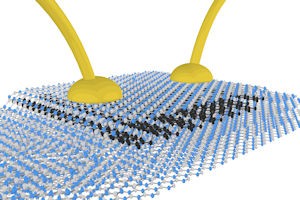Manchester Team Reveal New, Stable 2D Materials

The team created devices to stablise 2D materials
These 2D crystals are capable of delivering designer materials with revolutionary new properties.
The problem has been that the vast majority of these atomically thin 2D crystals are unstable in air, so react and decompose before their properties can be determined and their potential applications investigated.
Writing in NanoLetters, the University of Manchester team demonstrate how tailored fabrication methods can make these previously inaccessible materials useful.
By protecting the new reactive crystals with more stable 2D materials, such as graphene, via computer control in a specially designed inert gas chamber environments, these materials can be successfully isolated to a single atomic layer for the first time.
Combining a range of 2D materials in thin stacks give scientists the opportunity to control the properties of the materials, which can allow ‘materials-to-order’ to meet the demands of industry.
High-frequency electronics for satellite communications, and light weight batteries for mobile energy storage are just two of the application areas that could benefit from this research. The breakthrough could allow for many more atomically thin materials to be studied separately as well as serve as building blocks for multilayer devices with such tailored properties.
The team, led by Dr Roman Gorbachev, used their unique fabrication method on two particular two-dimensional crystals that have generated intense scientific interest in the past 12 months but are unstable in air: black phosphorus and niobium diselenide.
The technique the team have pioneered allows the unique characteristics and excellent electronic properties of these air-sensitive 2D crystals to be revealed for the first time.
The isolation of graphene in 2004 by a University of Manchester team lead by Sir Andre Geim and Sir Kostya Novoselov led to the discovery of a range of 2D materials, each with specific properties and qualities.
Dr Gorbachev said: “This is an important breakthrough in the area of 2D materials research, as it allows us to dramatically increase the variety of materials that we can experiment with using our expanding 2D crystal toolbox.
“The more materials we have to play with, the greater potential there is for creating applications that could revolutionise the way we live.” Sir Andre Geim added.
Notes for editors
The paper, Quality Heterostructures from Two-Dimensional Crystals Unstable in Air by Their Assembly in Inert Atmosphere, by Y. Cao, A. Mishchenko, G. L. Yu, E. Khestanova, A. P. Rooney, E. Prestat, A. V. Kretinin, P. Blake, M. B. Shalom, C. Woods, J. Chapman, G. Balakrishnan, I. V. Grigorieva, K. S. Novoselov, B. A. Piot, M. Potemski, K. Watanabe, T. Taniguchi, S. J. Haigh, A. K. Geim, and R. V. Gorbachev, is available from the Press Office on request.
Dr Gorbachev is available for interview on request.
Images and more information on graphene can be found at www.graphene.manchester.ac.uk
For media enquiries please contact:
Daniel Cochlin
Graphene Communications and Marketing Manager
The University of Manchester
0161 275 8382
07917 506158
www.graphene.manchester.ac.uk
www.manchester.ac.uk
Twitter: @UoMGraphene
Media Contact
All latest news from the category: Materials Sciences
Materials management deals with the research, development, manufacturing and processing of raw and industrial materials. Key aspects here are biological and medical issues, which play an increasingly important role in this field.
innovations-report offers in-depth articles related to the development and application of materials and the structure and properties of new materials.
Newest articles

Combining robotics and ChatGPT
TUM professor uses ChatGPT for choreographies with flying robots. Prof. Angela Schoellig has proved that large language models can be used safely in robotics. ChatGPT develops choreographies for up to…

How the Immune System Learns from Harmless Particles
Our lungs are bombarded by all manner of different particles every single day. Whilst some are perfectly safe for us, others—known as pathogens—have the potential to make us ill. The…

Biomarkers identified for successful treatment of bone marrow tumours
CAR T cell therapy has proven effective in treating various haematological cancers. However, not all patients respond equally well to treatment. In a recent clinical study, researchers from the University…





















